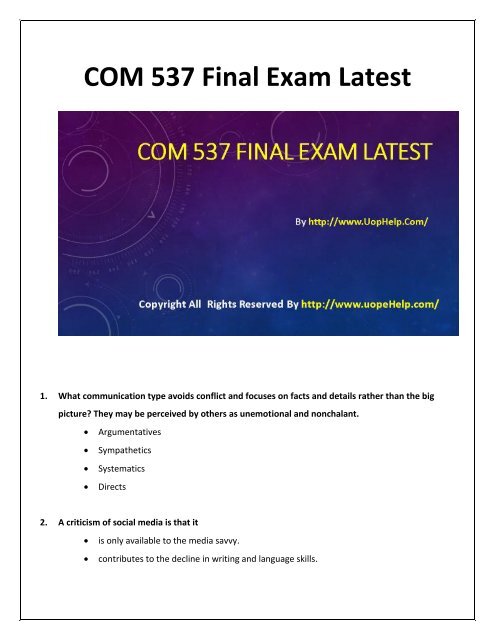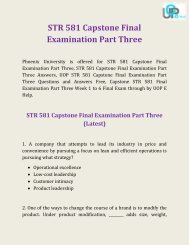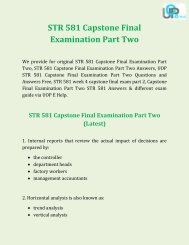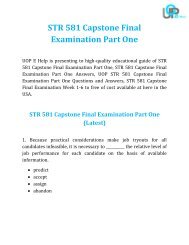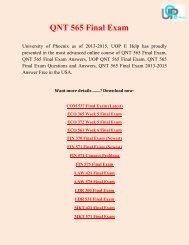COM 537 Final Exam (Latest) - Assignment.
COM 537 Final Exam Assignment.Excellence is all about spotting the right resources. Connect with us to join the community of instant learning on the COM 537 Final Exam Assignment, and many other subjects - http://www.uopehelp.com/University-of-phoenix/COM-537-Final-Exam.html
COM 537 Final Exam Assignment.Excellence is all about spotting the right resources. Connect with us to join the community of instant learning on the COM 537 Final Exam Assignment, and many other subjects - http://www.uopehelp.com/University-of-phoenix/COM-537-Final-Exam.html
You also want an ePaper? Increase the reach of your titles
YUMPU automatically turns print PDFs into web optimized ePapers that Google loves.
<strong>COM</strong> <strong>537</strong> <strong>Final</strong> <strong>Exam</strong> <strong>Latest</strong><br />
1. What communication type avoids conflict and focuses on facts and details rather than the big<br />
picture? They may be perceived by others as unemotional and nonchalant.<br />
<br />
<br />
<br />
<br />
Argumentatives<br />
Sympathetics<br />
Systematics<br />
Directs<br />
2. A criticism of social media is that it<br />
<br />
<br />
is only available to the media savvy.<br />
contributes to the decline in writing and language skills.
leads to separation of the haves and have-nots.<br />
leads to information overload<br />
3. In Korean culture, a business deal is dependent on contractual information as well as how the<br />
parties perceive each other’s values and ethics. According to Edmund Hall, this behavior<br />
exhibits the theory of<br />
<br />
<br />
<br />
<br />
proxemics<br />
low-context cultures<br />
Ethno-centricism<br />
high-context cultures<br />
4. Your supervisor sends you an e-mail requesting an article for the employee newsletter about<br />
company loyalty. You write the article featuring customers who are brand loyal. Later, your<br />
supervisor criticizes you for not writing about the topic that he requested. After a face-to-face<br />
meeting, you realize that he wanted you to write about employee loyalty. This is an example<br />
of what type of noise?<br />
<br />
<br />
<br />
<br />
Unwanted<br />
External<br />
Semantic<br />
Internal<br />
Want more details? Download now <strong>COM</strong> <strong>537</strong> <strong>Final</strong> <strong>Exam</strong><br />
5. The head of the holiday party committee at your office is trying to set a location for the<br />
event. The committee chairperson announces three choices for members to vote on. When<br />
Erin hears that the Boar’s Tavern is one of the choices, her mind is made up. After all, the<br />
restaurant is only a few blocks from her house. How would you describe her listening<br />
behavior?<br />
<br />
Active
Passive<br />
Agenda-setting<br />
Obtuse<br />
6. Your supervisor has the habit of coming into your office and leaning over your desk to talk to<br />
you. This situation is uncomfortable for you because you cannot move away from him.<br />
According to Edmund Hall, this behavior exhibits the theory of<br />
<br />
<br />
<br />
<br />
high-context cultures<br />
low-context cultures<br />
ethnocentricism<br />
proxemics<br />
7. Which statement is true concerning the role of publics in business communication?<br />
<br />
<br />
<br />
<br />
Publics, in general, remain constant despite changes in the environment.<br />
Internal publics are usually not concerned with the communication style used by<br />
management.<br />
External publics are not concerned with an organization’s public performance.<br />
Publics can dispel rumors and build positive brand image.<br />
8. A break-in at your company has resulted in the theft of various pharmaceutical products. The<br />
head chemist, slated as the company’s designated spokesperson, is scheduled to appear at a<br />
media conference. This course of action illustrates one of the steps in crisis communication<br />
planning. Select the appropriate step:<br />
<br />
<br />
<br />
<br />
Assessing the possible risk to the organization<br />
Evaluating the effectiveness of your action plan<br />
Identifying levels of vulnerability in your company<br />
Implementing the action plan<br />
Complete Answers just a click away <strong>COM</strong> <strong>537</strong> Complete Answer
9. In the management journal article about persuading customers that your boss recommended,<br />
you read that your style of hard selling is not effective with young professionals. You begin to<br />
question if you need to take a sales training seminar. This is an example of<br />
<br />
<br />
<br />
<br />
cognitive dissonance<br />
agenda-setting<br />
selective attention<br />
selective exposure<br />
10. Building strong coalitions among individuals or groups that have separate interests is called<br />
<br />
<br />
<br />
<br />
facilitation<br />
negotiation<br />
diversification<br />
mediation<br />
11. When Joseph Kline, a U.S. citizen working for a bakery in Pakistan, is surprised that he will<br />
have to work on December 25, Christmas Day, he is dealing with which component of the<br />
transactional communication model?<br />
<br />
<br />
<br />
<br />
Internal noise<br />
External noise<br />
Cultural relativism<br />
Context<br />
12. Which of the following statements is true?<br />
<br />
<br />
<br />
<br />
Semantics is the study of the meaning of words, phrases, and texts<br />
Semantics is the study of how words affect the decision-making process<br />
Semantics is the study of dictionary definitions<br />
Semantics is the study of the use of words in persuasive communication
Quiz Answers just a click away <strong>COM</strong> <strong>537</strong> <strong>Final</strong> Questions And Answers<br />
13. What affects how others perceive us and can adjust according to the situation?<br />
<br />
<br />
<br />
<br />
Feedback<br />
Channel<br />
Communication style<br />
Personality<br />
14. What describes the occasion, time, and place of communication in the transactional<br />
communication model?<br />
<br />
<br />
<br />
<br />
Cognitive dissonance<br />
Context<br />
Channel<br />
Noise<br />
15. A beer commercial shows young people laughing while enjoying bottles of Mountain Beer in<br />
a busy bar scene. According to Maslow’s hierarchy, which consumer need is targeted?<br />
<br />
<br />
<br />
<br />
physiological needs<br />
self-esteem<br />
belonging<br />
self-actualization<br />
16. With the overload of information today, what does Smith (2010) state communication must<br />
be to be noticed?<br />
<br />
<br />
<br />
<br />
Familiar and consistent<br />
Timely and thorough<br />
Innovative and creative<br />
Informative and detailed
To download the complete course check <strong>COM</strong> <strong>537</strong> Entire Course<br />
17. “To provide the best health care for our patients at a reasonable cost” is an example of<br />
<br />
<br />
<br />
<br />
a mission statement<br />
a vision statement<br />
a corporate objective<br />
a strategic plan<br />
18. In the process of behavior change, after people have detected the presence of a problem and<br />
they see this problem as important, to what phase do they belong?<br />
<br />
<br />
<br />
<br />
Diversification<br />
Decision<br />
Detection<br />
Implementation<br />
19. In the transactional communication model, who or what is responsible for composing a<br />
message embedded with meaning from his or her world while considering the interpretative<br />
resources that will be used to decode the message?<br />
<br />
<br />
<br />
<br />
Effective message area<br />
Receiver<br />
Channel<br />
Sender<br />
20. What is a tactic described by Lencioni (2010) to disarm clients and allow them to trust a<br />
consultant?<br />
<br />
<br />
<br />
<br />
Prove detailed information<br />
Provide references<br />
Be comfortable and naked with weaknesses<br />
Promote strengths and past successes
Click here to download Complete <strong>Assignment</strong> of <strong>COM</strong> <strong>537</strong> Complete <strong>Assignment</strong><br />
21. In 2006, Walt Disney Parks and Resorts launched a new theme for its integrated global<br />
marketing efforts. Which of the following was identified as an integrated marketing strategy<br />
element?<br />
<br />
<br />
<br />
<br />
Disney used the theme “Year of a Million Dreams” in its publicity and promotional<br />
materials.<br />
Disney avoided the use of ads, contests, and sweepstakes.<br />
Disney sent out several messages over a broad a spectrum of media to appeal to the<br />
largest<br />
Disney positioned itself as a “transformational experience” to one specific age group.<br />
22. What factor must be considered in designing an effective communication system?<br />
<br />
<br />
<br />
<br />
The costs involved<br />
The needs of the customer<br />
The message delivery<br />
The optimal combination of a message, source, channel, and an operating variable<br />
23. You have been charged with writing a report on the progress of the integration of a database<br />
between organizational units. Your supervisor says that she wants the report as soon as<br />
possible. You spend your weekend working on the report in order to have it ready<br />
by Monday morning. When you present the report to your supervisor, she says, “I am sorry<br />
that you spent your weekend on the report; it wasn’t that urgent.” This scenario is an<br />
illustration of a problem with what element in the transactional communication model?<br />
<br />
<br />
<br />
<br />
Cognitive dissonance<br />
Context<br />
Channel<br />
Noise
24. In changing markets, communication tactics<br />
<br />
<br />
<br />
<br />
are based on techniques used in traditional markets<br />
use a combination of traditional and new media<br />
do not require the use of conventional databases<br />
are mass media-driven<br />
Find the final exam answers here <strong>COM</strong> <strong>537</strong> <strong>Final</strong> <strong>Exam</strong> <strong>Latest</strong>.<br />
25. In the 20th century, the public relations profession was reshaped by one of the following<br />
events:<br />
<br />
<br />
<br />
<br />
The split of public relations functions from advertising agencies<br />
The decline of mergers and acquisitions in big business<br />
The rise of the patent medicine industry<br />
The growth of electronic media<br />
26. How does Lencioni (2010) describe “entering the danger”?<br />
<br />
<br />
<br />
<br />
Addressing a client’s potentially explosive issues<br />
Developing a new market niche<br />
Analyzing competition<br />
Being vulnerable<br />
27. Good listeners generally concerned with everyone’s needs, maintaining relationships, and<br />
avoiding conflict describes this communication style generally perceived as soft-hearted and<br />
overly helpful.<br />
<br />
<br />
<br />
<br />
Directs<br />
Systematics<br />
Argumentatives<br />
Sympathetics
28. Suppose you are asked to discuss an American Indian ceremony. Perhaps you describe the<br />
use of peace pipes, drums, feathered headdresses and dancing and chanting around a fire.<br />
This information is an example of<br />
<br />
<br />
<br />
<br />
forming a negative stereotype based on inaccurate information<br />
assigning neutral traits stereotypes<br />
“knowing” a group of people<br />
using mediated information to add to your knowledge<br />
Complete paper here <strong>COM</strong> <strong>537</strong><br />
29. A manager informs her staff that there is a problem with office equipment abuse. She<br />
suggests that each employee should come up with a list of ways to cut down on the repair<br />
bills. The suggestions will be discussed at the next department meeting. Which of the three<br />
leadership types outlined by theorists Lewin, Lippert, and White does this manager’s request<br />
illustrate?<br />
<br />
<br />
<br />
<br />
Democratic<br />
Laissez-faire<br />
Authoritarian<br />
Republican<br />
30. You notice that a colleague seems to be distracted from his work. You ask him if something is<br />
wrong, and he replies, “No, I’m fine”. You ask him again, “Tell me what is wrong”? This is an<br />
example of<br />
<br />
<br />
<br />
<br />
believing non-verbal clues over verbal language<br />
engaging in interpersonal observation<br />
altering communication cues<br />
believing verbal over non-verbal messages
About Author:<br />
This article covers the topic for the University Of Phoenix <strong>COM</strong> <strong>537</strong> <strong>Final</strong> <strong>Exam</strong><br />
<strong>Latest</strong>. The author is working in the field of education from last 5 years. This<br />
article covers the basic of <strong>COM</strong> <strong>537</strong> Entire Course from UOP. Other topics in the<br />
class are as follows:<br />
<strong>COM</strong> <strong>537</strong> <strong>Final</strong> <strong>Exam</strong> (<strong>Latest</strong>) UOP<br />
Want to check other classes..?? Visit http://www.UOPehelp.com/


